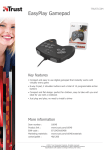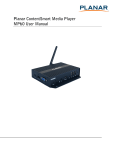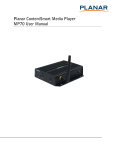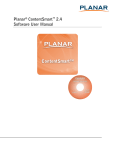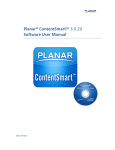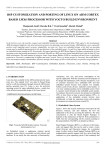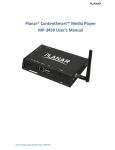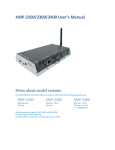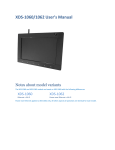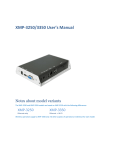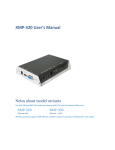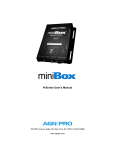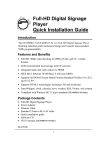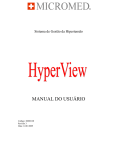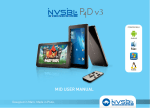Download Planar ContentSmart Media Player MP70 OPS User Manual
Transcript
Planar ContentSmart Media Player MP70 OPS User Manual Contents 1 Overview ............................................................................................................................................................ 3 1.1 Feature Highlights ....................................................................................................... 3 1.2 Package Contents ........................................................................................................ 4 1.3 Installation...................................................................................................................... 4 1.3.1 Mounting.............................................................................................................................. 4 1.4 Physical View ................................................................................................................. 5 1.4.1 Physical features ................................................................................................................ 5 2 Configuring the Player .................................................................................................................................. 6 2.1 System Connections ................................................................................................... 6 2.2 Basic Settings ................................................................................................................ 7 2.3 Connect the Player to Your Network .................................................................... 8 2.3.1 Wireless connection ......................................................................................................... 8 2.3.2 Static IP – manually assign network IP address ..................................................... 9 2.3.3 Wired connection............................................................................................................ 10 2.3.4 Proxy settings ................................................................................................................... 11 2.3.5 Show IP settings .............................................................................................................. 13 2.4 Time Zone Settings .................................................................................................. 14 2.5 Content Settings ....................................................................................................... 14 2.6 Player Information.................................................................................................... 17 2.7 Content Configuration – AppStart ..................................................................... 18 2.8 Content Configuration – FailSafe........................................................................ 19 2.9 Content Configuration – EasyPlay ...................................................................... 20 2.10 Display Settings ...................................................................................................... 24 2.11 Sound Settings........................................................................................................ 27 2.12 System Configuration – Player Name ............................................................. 28 2.13 System Configuration – Security ...................................................................... 29 2.14 System Configuration – Time Server .............................................................. 30 2.15 System Configuration – Scheduled Reboot ................................................. 30 2.16 System Configuration - Firmware Update .................................................... 31 2.17 System Configuration – Expansion Storage ................................................. 32 2.17.1 Manual Expansion..................................................................................................... 33 2.17.2 Auto Expansion .......................................................................................................... 34 2.18 System Configuration - Factory Reset ............................................................ 35 2.18.1 Using the reset button ............................................................................................ 35 2.18.2 Using a USB mouse ................................................................................................... 35 2.19 System Configuration – Power Save ............................................................... 36 3 Content Management ................................................................................................................................ 37 4 Authoring in HTML5 .................................................................................................................................... 37 5 Working with SMIL ....................................................................................................................................... 37 5.1 Introduction................................................................................................................ 37 5.2 www.a-smil.org for Developers ........................................................................... 38 6 MP70 OPS Specifications ........................................................................................................................... 38 7 Technical Support......................................................................................................................................... 39 7.1 FAQ ................................................................................................................................ 39 7.2 Planar Support ........................................................................................................... 42 7.2.1 Cables and Accessories ................................................................................................. 42 7.2.2 Contact Planar .................................................................................................................. 42 Planar ContentSmart MP70 OPS User Manual 2 1 Overview This document describes the hardware operation of the Planar® ContentSmart™ Media Player MP70 OPS, system set-up and frequently asked questions. 1.1 Feature Highlights The Planar ContentSmart MP70 OPS is a UHD (3840 x 2160) high definition digital signage media player featuring industrial-grade OPS format mechanical design and versatile open-standard HTML5 and SMIL programmability. • Power / Status LED indicator • 3.5mm composite Audio output • Ethernet port for network content update • Wireless antenna post • JAE Connector for display mountingAV in for custom live content display • Hardware decoding of MPEG1/2/4, H.264, H.265, and VC-1 media formats • 8GB on-board flash local storage with Micro SD expansion slot with SD card cover • 2 USB ports for USB content update and configuration • S/W Reset button to perform factory reset • Built-in wireless b/g/n network • Support for HTML5 widgets for dynamic content (W3C Widgets standard) • Industry leading W3C SMIL support for developers • Supports full POPAI Screen Media Formats Standards profiles S1 to S12, and E1 to E8 Planar ContentSmart MP70 OPS User Manual 3 1.2 Package Contents Media Player Unit Wi-Fi Antenna NOT INCLUDED: A USB mouse is required for system setup Micro SD card 1.3 Installation 1.3.1 Mounting ATTACH the wireless antenna as shown in figure below. Screw antenna clockwise onto the post. PLUG the player into the OPS slot of the monitor and push until it is securely plugged in the display. Planar ContentSmart MP70 OPS User Manual 4 1.4 Physical View 1.4.1 Physical features Planar ContentSmart MP70 OPS User Manual • Power/Status LED indicator • 3.5mm composite Audio output • Ethernet port for network content update • Wireless antenna post • Micro SD card slot with SD card cover • USB ports for USB content update and configuration • S/W Reset button to perform factory reset • JAE Connector for display mounting 5 2 Configuring the Player 2.1 System Connections Connect to a monitor via an OPS slot. Attach the AC power adapter to power on the unit. After approximately 15 seconds, the booting animation will be displayed on screen as shown below: Figure 2.1.1 The boot-up process takes approximately 40 seconds to complete. Figure 1.1.2 After boot-up completes, player will stay in Basic settings menu if no content service has been configured (i.e. first boot-up for brand new unit or after a factory reset). Planar ContentSmart MP70 OPS User Manual 6 Note: If you have already sent content to the player, content will play back automatically 15 seconds after boot-up. 2.2 Basic Settings A USB mouse must be attached to the player to configure settings. If the display has a HIDcompliant touch screen, a USB mouse is not required and all the click action can be replaced by tap actions. Figure 2.2.1 Basic Settings: Network Time zone Content Each time the Basic settings menu is entered, playback will automatically begin after 15 seconds if content services have been previously set. Auto playback can be canceled by clicking on the button before the countdown ends. User is able to enter Advanced Settings by clicking the Advanced button. To enter the menu system at any time during playback, plug in a USB mouse and hold the left mouse key in the corner area as shown below for 10 seconds. If the player has touch screen, tapping and holding in the corner areas for 10 seconds will also bring you to the menu. Figure 2.2.2 Note: Player will ask for password if password has been configured. Planar ContentSmart MP70 OPS User Manual 7 2.3 Connect the Player to Your Network 2.3.1 Wireless connection Click the Wireless LAN setting to launch the wireless configuration UI. Figure 2.3.1 Click the ON/OFF button as indicated below to turn ON Wireless interface (network). Figure 2.3.2 The player will scan for wireless signals nearby and available access points will be listed. Planar ContentSmart MP70 OPS User Manual 8 Figure 2.3.3 Click on the network ID to connect. If the network requires authentication, you will be asked to provide a password. Figure 2.3.4 2.3.2 Static IP – manually assign network IP address 1 Planar ContentSmart MP70 OPS User Manual Check the box that says "Show advanced options" 9 Figure 2.3.5 Click down arrow to hide keyboard if needed. You can also scroll down/ swipe to see the rest of the menu. 2 Under IP settings, change DHCP to Static. Figure 2.3.6 3 Fill the form and click Connect to complete the setting. (Scroll down/ swipe to see the rest of the menu if needed) Figure 2.3.7 2.3.3 Wired connection To use the wired Ethernet connection, connect an Ethernet cable. Ethernet connection takes priority over wireless connection. DHCP – Automatically assign network IP address Planar ContentSmart MP70 OPS User Manual 10 1 Turn on Ethernet by checking the “Use Ethernet” box. If using DHCP, no further action is required. Figure 2.3.8 Static IP – Manually assign network IP address 1 Click Static IP Settings to configure static IP address. Figure 3 2.3.4 Proxy settings 1 Planar ContentSmart MP70 OPS User Manual In Basic settings, click the Advanced button and the advanced configuration menu will be launched. 11 Figure 4.10 2 Click Network, then click Advanced. Figure 2.3.11 3 Planar ContentSmart MP70 OPS User Manual Proxy setting menu will be launched. Input proxy hostname and port, then click Done to finish configuration. 12 Figure 2.3.12 2.3.5 Show IP settings 1 In Basic settings, click the Advanced button and the advanced configuration menu will be launched. (Figure 12) 2 Click Network, then click Show IP. Figure 2.3.13 3 This feature is to control whether the IP address is displayed in the Basic settings menu. This is enabled by default. When disabled, basic settings will display “connected” instead of the assigned IP address. Figure 2.3.14 Planar ContentSmart MP70 OPS User Manual 13 2.4 Time Zone Settings 1 In Basic Settings, click Time zone. Figure 2.4.1 2 Choose the correct time zone from the available options. Figure 2.4.2 2.5 Content Settings 1 Planar ContentSmart MP70 OPS User Manual Click the Set content button. 14 Figure 2.5.1 2 Input the SMIL/HTML5 content URL and click Set. It will return to Basic Settings automatically. Figure 2.5.2 3 The player will check the availability of SMIL/HTML5 content URL, with the Play button showing Checking… The checking action can be canceled by clicking Checking… button. It will change back to Play. Planar ContentSmart MP70 OPS User Manual 15 NOTE: It is highly recommended to let the player check the availability of the content URL. Clicking Play button with a bad/invalid URL set will cause the player to reboot if the FailSafe function is not configured. Figure 2.5.3 4 If the SMIL/HTML5 content URL is available, the Play button will change to a 15-second countdown and the playback will start after the countdown. The countdown can be canceled by clicking the button. If it keeps showing Checking… for a long time, please go back to Set content to check the correctness of the URL. Figure 2.5.4 Planar ContentSmart MP70 OPS User Manual 16 2.6 Player Information Users can check the player’s basic information including the Health status, Firmware version and Player ID. 1 Click the Advanced button and the advanced configuration menu will be launched. Figure 2.6.1 2 Click on Information. The definitions of the Health Status: Green – Normal. The device is connected to the URL server. Blue – Local. The device is playing content from the USB drive or SD card. Gray – Disconnected. The device is disconnected. Planar ContentSmart MP70 OPS User Manual 17 Figure 2.6.2 2.7 Content Configuration – AppStart Users can assign the URL and APP for execution right after the system starts up. 1 Click the Advanced button. (Figure 2.6.1) 2 Click on Content, then click on AppStart. 3 Enter the valid URL of HTML/SMIL in AppStart (Figure 2.7.1). If you already configured SMIL/HTML5 content URL via ”Set content” (Figure 2.5.2), the URL would be showed here. 4 The Advanced option is used for 3rd-party App configuration only. Planar ContentSmart MP70 OPS User Manual 18 Figure 2.7.1 2.8 Content Configuration – FailSafe Users can assign the URL and APP for execution while the system has failed to play the assigned content. 1 Click the Advanced button and the advanced configuration menu will be launched. (Figure 2.6.1) 2 Click on Content, then click on FailSafe. 3 Enter the URL of HTML/SMIL in FailSafe. 4 The Advanced option is used for 3rd-party App configuration only. Planar ContentSmart MP70 OPS User Manual 19 Figure 2.8.1 2.9 Content Configuration – EasyPlay The EasyPlay feature allows the player to play media content from the USB flash drive (or MicroSD card) directly. Please note media files does not copied to player’s internal storage so USB flash drive (or Micro SD card) must not be removed. When EasyPlay is enabled, the player will play content only from the USB drive (or MicroSD card). If user wants to play content from the URL server configured via ”Set content”, EasyPlay must be disabled. 1 Insert USB drive or MicroSD card containing media content to play. 2 Click the Advanced button. (Fig. 2.6.1) 3 Click on Content, then click on EasyPlay. 4 Click Disabled/Enabled button to enable EasyPlay, and choose from 2 available operation modes, Photo Mode and Movie Mode. Planar ContentSmart MP70 OPS User Manual 20 Figure 2.9.1 Configure Photo Mode: 1 Click on Photo for choosing photos and music. Click on the buttons as marked in red below and select the directories for photos and music from the USB drive. 2 Click Set button after selecting the directories. Figure 2.9.2 Planar ContentSmart MP70 OPS User Manual 21 Configure Movie Mode: 1 Click on Movie. Click on the button as marked in red below and select the directory for movies from the USB drive. 2 Click Set button after the folder is selected. 3 The files in the selected folders will be played after clicking the Play button in the Basic or Advanced settings menu. Figure 2.9.3 EasyPlay Schedule Configuration: 1 Click the Advanced button. (Fig. 2.6.1) 2 Click on Content, then click on Schedule. 3 Click on the buttons marked in red below to enable/disable the EasyPlay schedule for each time slots. Type the scheduled time in the dialogue boxes marked in blue below by using the pop-up keyboard or the USB keyboard. Planar ContentSmart MP70 OPS User Manual 22 Figure 2.9.4 4 The "On" times assigned in the time slots A-E are inclusive. For example, a schedule assigned per the example below: Figure 2.9.5 The exact playback time will be the time slots marked in blue as shown in figure 2.9.6. The dark blue parts are the overlap time of C/D and D/E. Planar ContentSmart MP70 OPS User Manual 23 Figure 2.9.6 2.10 Display Settings Resolution Settings: For best quality, set the output resolution to match your display’s native resolution to avoid image scaling and blur. If you are connecting an LCD computer monitor, projector or plasma display, refer to the device specifications for optimal settings. 1 Click the Advanced button and the advanced configuration menu will be launched. (Fig. 2.6.1) 2 Click the Display/sound button, then click on Display. The Display Settings page will be launched. Planar ContentSmart MP70 OPS User Manual 24 Figure 2.10.1 3 Click on Resolution and select suitable resolution from the pop-up menu. Default configuration is Auto Detect - player will auto detect and use the best optimized resolution that your display supports. Figure 2.10.2 Planar ContentSmart MP70 OPS User Manual 25 Figure 2.10.3 Screen Orientation: Screen orientation is to set the display to rotate 90/180/270 degrees. 4 Click the Advanced button and the advanced configuration menu will be launched. (Fig. 2.6.1) 5 Click the Display/sound button, then click on Display. The Display Settings page will be launched. (Fig. 2.10.1) 6 Click on the Screen orientation marked in red below. Figure 2.10.4 7 Planar ContentSmart MP70 OPS User Manual Click on the preferred angle from the menu. 26 Figure 2.10.5 2.11 Sound Settings To control the output sound volumes and touch sounds: 1 Click the Advanced button and the advanced configuration menu will be launched. (Fig. 2.6.1) 2 Click the Display/sound button, then click on Sound. The Sound Settings page will be launched. Figure 2.11.1 3 Planar ContentSmart MP70 OPS User Manual Click on Volumes and the Volumes settings page will be launched. Drag the blue sliders to adjust the volumes for the selected options, then click OK to save the new settings. 27 Figure 2.11.2 Figure 2.11.3 2.12 System Configuration – Player Name The player’s name can be specified so the player can be easily recognized in the management software (Management software support is required). 1 Click the Advanced button and the advanced configuration menu will be launched. (Fig. 2.6.1) 2 Click on System, then click on Player name. 3 Input a name for the field and click Set. Planar ContentSmart MP70 OPS User Manual 28 Figure 2.12.1 2.13 System Configuration – Security A password can be set to provide authentication for player access. If the password is set, a password prompt will appear if a user is trying to enter the Basic settings menu from playback. 1 Click the Advanced button and the advanced configuration menu will be launched. (Fig. 2.6.1) 2 Click on System, then click on Security. 3 Input a password in the field and click Set. Figure 2.13.1 Planar ContentSmart MP70 OPS User Manual 29 2.14 System Configuration – Time Server The feature allows user to synchronize player’s time with the web server where the appStart URL hosted. It is disabled by default. When disabled, player synchronize it’s time with Android default time server (pool.ntp.org). This requires and internet connection. When enabled, player synchronize it’s time with the web server where the appStart URL hosted (based on http response header’s time). 1 Click the Advanced button and the advanced configuration menu will be launched. (Fig. 2.6.1) 2 Click on System, then click on Time server. 3 Click the Use AppStart URL as time server button as marked in red below to enable/disable the time server function. 4 Click on Set to save the setting. Figure 2.14.1 2.15 System Configuration – Scheduled Reboot The Scheduled Reboot feature allows the player to reboot on the assigned time automatically every day. Planar ContentSmart MP70 OPS User Manual 30 1 Click the Advanced button and the advanced configuration menu will be launched. (Fig. 2.6.1) 2 Click on System, then click on Scheduled Reboot. 3 Click the Enable daily reboot button as marked in red below to enable/disable the daily reboot function. Click on the dialogue box to set the time. The value can be entered with the pop-up keyboard or the USB keyboard. 4 Click on Set to save the setting. Figure 2.15.1 2.16 System Configuration - Firmware Update Firmware updates can be performed by using a USB flash drive. Please read the release notes regarding the changes that will be made to your player before applying the upgrade. IMPORTANT: DO NOT unplug the USB drive or power down the player while the system is performing the firmware update. 1 Download the latest firmware from http://www.planar.com/contentsmart and copy it to the root directory of a USB drive. 2 Plug in the power cord into the device. 3 After the boot-up completes, click the Advanced button on the Basic settings menu. (Fig. 2.6.1) Planar ContentSmart MP70 OPS User Manual 31 4 Click on System, then click Firmware update. 5 Click on OK to begin the firmware update. Figure 2.16.1 6 Plug in the USB drive while the screen shows “Scanning USB drives for firmware package.” Figure 2.16.2 2.17 System Configuration – Expansion Storage Users may use a MicroSD card for content storage in place of the main device storage. Please note that internal storage is disabled when using a MicroSD card. Planar ContentSmart MP70 OPS User Manual 32 2.17.1 Manual Expansion 1 Power off device. 2 Insert Micro SD card, then plug in power cord to power on. 3 In the Basic settings menu, click the Advanced button and the advanced configuration menu will be launched. (Fig. 2.6.1) 4 Click on System, click on Expansion storage and click Initialize. Player will format Micro SD card then reboot by itself. Figure 2.17.1 Figure 2.17.2 5 After boot up, check player information and new capacity will be displayed. Planar ContentSmart MP70 OPS User Manual 33 Figure 2.17.3 2.17.2 Auto Expansion 6 In the Basic settings menu, click the Advanced button and the advanced configuration menu will be launched. (Fig. 2.6.1) 7 Click on System, click on Expansion storage and enable auto-format. Figure 2.17.4 8 Power off device. Planar ContentSmart MP70 OPS User Manual 34 9 Insert Micro SD card, then plug in power cord to power on. 10 After boot up, check player information and new capacity will be displayed.(Fig 2.17.3) 2.18 System Configuration - Factory Reset If you forget the system password you have set, you must reset the system to regain access to the player. 2.18.1 Using the reset button 1 PRESS and HOLD the reset button with a pin. 2 RE-CONNECT the power cord. 3 WAIT until the status LED flashes. 4 RELEASE reset button and wait for system to initialize. 2.18.2 Using a USB mouse System reset will re-initialize the system, clear passwords, and return settings to their default values. Perform the following: 5 CONNECT a USB mouse or using touch screen for input. 6 Click the Advanced button and the advanced configuration menu will be launched. (Fig. 2.6.1) 7 Click on System configuration and choose Factory default. 8 Click on OK button to perform the system reset. Planar ContentSmart MP70 OPS User Manual 35 Figure 2.18.1 2.19 System Configuration – Power Save The Power Save feature allows the player to power off automatically while staying at the Basic settings menu without any action taken for 10 minutes. 1 Click the Advanced button and the advanced configuration menu will be launched. (Fig. 2.6.1) 2 Click on System, then click on Power save. 3 Click the Enable Power Save mode button as marked in red below to enable/disable the power save function. 4 Click on Set to save the setting. Planar ContentSmart MP70 OPS User Manual 36 Figure 2.19.1 3 Content Management Please refer to the Planar ContentSmart User Manual for instructions. 4 Authoring in HTML5 A major advancement in the player is the ability to playback HTML5 content which can contain dynamic information. To find out more about using HTML5 for digital signage, visit http://www.digisignage.com/ 5 Working with SMIL The player uses open communications protocols for content presentation and playback control. SMIL-compliance means predictable results across multiple devices. SMIL’s non-proprietary nature means that your investments are never obsolete. 5.1 Introduction Planar ContentSmart MP70 OPS User Manual 37 Using SMIL (pronounced “smile”), the language created by W3C for multimedia communications, the media player understands the language “spoken” by professional tools from companies such as Adobe, Apple, Microsoft, and Real Networks. What this means is quicker, easier, and better integration of your players into your digital signage networks, opening up avenues of software controls and realizing the full potential of your player hardware down the road. 5.2 www.a-smil.org for Developers The media player operating system utilizes W3C SMIL as the underlying scripting language, which lends well to customization to your project management needs. For resources, downloads and community support, visit www.a-smil.org. 6 Video format support MP70 OPS Specifications H.264/AVC up to 2160p @24fps (3840x2160) MPEG-4 up to 1080p @60fps (1920x1080) MPEG-2 up to 1080p @24fps (1920x1080) MPEG-1 up to 1080p @60fps (1920x1080) VC-1 up to 1080p @30fps (1920x1080) H.265/HEVC: 4k @60fps (4096x2160)up to 50Mbps bit rate Image format support JPEG Audio codec support MPEG Audio (MP3) Dynamic content W3C HTML5 (HTML, CSS, JavaScript) PNG W3C SMIL 3.0 instructions (sub-set) Physical I/O connectors JAE Connector 3.5mm audio out Wi-Fi antenna port RJ45 Ethernet USB 2.0 Planar ContentSmart MP70 OPS User Manual 38 8 GB eMMC Local storage Micro SD card expansion slot Wi-Fi antenna Accessories Micro SD card slot bracket/screw x1 Power requirement DC 12 – 19V Power consumption Average 7W Environmental Operating temperature: 0 – 50°C Humidity: 5 – 85% @ 45 °C non-condensing Dimensions 7.08"x 4.68"x 1.18" (180mm x119mm x30mm) Weight 0.73 lbs (332g) Certifications CE, FCC, IC, RoHS Warranty Three years 7 Technical Support 7.1 FAQ The operation indicators light up but no video is displayed on the screen Ensure that your player is securely plugged into the display. Check if your monitor is turned on. What video format can I play? Video files encoded in MPEG-4 AVC up to 1920x1080 resolution at 10 Mbps bitrates or HEVC H.265 up to 20 Mbps bitrates should play fine. If a certain video does not played as scheduled, or if it plays poorly contact Planar Support. The player is placed near my Wi-Fi access point, yet the connection is unreliable. Wi-Fi appliances in general should be placed 10 feet (3 meters) from the Wi-Fi access point for reliable operation. Try relocating the access point further away from the player to improve connection. Planar ContentSmart MP70 OPS User Manual 39 If both Ethernet & Wi-Fi are connected, which one will take precedence? If both connections are available, Ethernet will be used. What should I do if I forgot my password? Please perform a factory reset. Use the S/W RESET button located at the back of the media player to restore factory settings. This will also clear the player’s password. How do I manage the playback of contents? The media player is designed to be interoperable with leading 3rd party management software solutions or via SMIL open standard commands. Can the player display Flash or Microsoft PowerPoint presentations? The player features limited PowerPoint support, but not Flash support. While PCs can play many formats with varying degrees of success, RISC-based media players are designed to reliably play specific video formats (see spec for details). While Microsoft PowerPoint native files cannot play directly on a RISC-based player, the file can be converted into an image format to be played as an image slideshow. Why won’t some media files play properly? The video data bit-rate used may have exceeded the recommended bit rate. The video data bit-rate is the amount of video or audio data used per second to store or play the contents, usually expressed in Mbps (mega-bits per second). Video encoded with excessive bit-rates will not playback smoothly in the media player, likely due to storage I/O bottleneck. Visit http://www.planar.com/contentsmart for compatible media format presets. The media playback looks different on a PC compared to the media player’s screen. (Wrong aspect ratio) There are 2 major aspect ratios (width-to-height ratios) for video content, but there are many kinds of displays. If you play 4:3 video on a 16:9 display (or vice versa), a circle becomes oval and the picture takes on a squeezed or stretched look. To avoid this distorted look, adding black bars are a common technique. The Network Media Player can be configured to automatically add black bars for certain types of displays. You can set the output resolution in the player’s configuration menu to match the native resolution of your display. Planar ContentSmart MP70 OPS User Manual 40 Some JPEG images cannot be played in the media player. The media player works best with 4K UHD (3840 x 2160) images. Playback of native images directly from the camera may result in an image being displayed incorrectly or not at all. Does the media player support video streaming? No. Media players play files from local storage and do not support real-time video streaming over the network. This delivers an optimum viewing experience free of playback quality issues such as stuttering, blocking or blue-screens. The player is not playing. What should I do? Play list errors and scheduling issues are two major causes of playback problems. To determine if the problem is caused by a bad playlist, delete the playlist and restart the player. The player should loop through all media files, indicating a fault with the playlist. If the playback is scheduled to play at specific time, check to see if the device is set to the right time zone on the world clock. If nothing seems wrong, the time zone setting is often the reason the program is not played. The video is playing but I can’t hear any sound, what should I do? Check volume (mute) settings on monitor. Planar ContentSmart MP70 OPS User Manual 41 7.2 Planar Support 7.2.1 Cables and Accessories To find cables and accessories for your Planar monitor, touch screen or other Planar products visit our online store at www.PlanarOnline.com. 7.2.2 Contact Planar Visit Planar at www.planar.com/Support for operations manuals, touchscreen drivers, warranty information and access to Planar's Technical Library for online trouble shooting. To speak with Planar Customer Support, have your model and serial number available and call: Planar Support Tel: 1-866-PLANAR1 (866-752-6271) or +1 503-748-5799 outside the US Hours: 24 hours a day, 7 days a week Toll or long distance charges may apply. Planar ContentSmart MP70 OPS User Manual 42 Planar Systems, Inc. Customer Service 24x7 Online Technical Support: www.planar.com/Support 1195 NW Compton Drive Beaverton, OR 97006-1992 Tel: 1-866-PLANAR1 (866-752-6271), +1 503-748-5899 outside the United States Hours: 24 hours a day, 7 days a week © 2015 Planar Systems, Inc. 9/2015 Planar is a registerd trademark of Planar Systems, Inc. Other brands and names are the property of their respective owners. Technical information in this document is subject to change without notice. 020-1292-00A












































